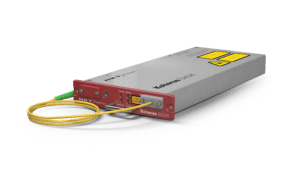Optical tweezers (originally called single-beam gradient force trap) are scientific instruments that use a highly focused laser beam to hold and move the microscopic and sub-microscopic objects like atoms, nanoparticles and droplets, in a manner similar to tweezers. If the object is held in air or vacuum without additional support, it can be called optical levitation.
NKT Photonics has been the go-to brand for successful implementation of optical tweezers or standing wave-type dipole traps, using their Koheras product line. When working with the Koheras BOOSTIK and its efficient and stable wavelength conversion module, the Koheras HARMONIK, you can address the dipole trapping wavelengths of your favorite atoms such as Strontium or Rubidium. Wavelength conversion also quenches any ASE in the laser system and ensures a spectrally pure signal. With its high power, ASE suppression through conversion, lack of chillers, and fiber-delivered light, the Koheras lasers are ideal for dipole trapping in the lab and the rack. Read more about Quantum Technology and Optical Tweezers!
Did you know:
- The Koheras lasers have been designed for a lifetime of above 10 years in demanding environments where uptime is critical? With failure rates lower than 1%, it is the most reliable low-noise lasers on the market. Alignment-free and maintenance-free!
- That more than 15,000 Koheras lasers have been deployed in the harshest environments on- and off-planet. There are lasers installed on oil rigs, submarines, wind turbines, and even in space. With over 20 years of experience, it has been proven that they last. Even in an environment as challenging as your lab.
- Time-domain optics for atomic quantum matter by Simon Kanthak, Martina Gebbe, Matthias Gersemann, Sven Abend, Ernst M Rasel, Markus Krutzik, published in New Journal of Physics, 2021.
- Twin-lattice atom interferometry by Martina Gebbe, Jan-Niclas Siemss, Matthias Gersemann, Hauke Müntinga, Sven Herrmann, Claus Lämmerzahl, Holger Ahlers, Naceur Gaaloul, Christian Schubert, Klemens Hammerer, Sven Abend, Ernst M. Rasel published in Nature Communications, 2021.
- Monolithic bowtie cavity traps for ultra-cold gases by Yanping Cai, Daniel G. Allman, Jesse Evans, Parth Sabharwal, Kevin C. Wright, published in Journal of the Optical Society of America B, 2020.
- Atom interferometry in a twin lattice with more than a thousand photon recoils thesis by Martina Gebbe, University of Bremen, 2020.
- An accordion-type lattice: A tuneable dipole trap for ultracold gasesthesis by Carolin Dietrich, University of Stuttgart, 2018.
- Multi-second magnetic coherence in a single domain spinor Bose–Einstein condensate by Silvana Palacios, Simon Coop, Pau Gomez, Thomas Vanderbruggen, Y. Natali Martinez de Escobar, Martijn Jasperse, Morgan W Mitchell, published in New Journal of Physics, 2018.
- Systematic optimization of laser cooling of dysprosium by Florian Mühlbauer, Niels Petersen, Carina Baumgärtner, Lena Maske, Patrick Windpassinger, published in Applied Physics B, 2018.
- BEC array in a Malleable Optical Trap formed in a Traveling Wave Cavity by D. S. Naik, G. Kuyumjyan, D. Pandey, P. Bouyer, A. Bertoldi, 2018.
- A simple 2 W continuous‑wave laser system for trapping ultracold metastable helium atoms at the 319.8 nm magic wavelength by R. J. Rengelink, R. P. M. J. W. Notermans, W. Vassen, published in Applied Physics B, 2016.
Source: https://www.nktphotonics.com/applications/quantum-nano-technology/dipole-trapping/
Thank you for reading, we hope you learned more about Quantum Technology and Optical Tweezers.
#koheras #NKT #quantum #tweazers #laser

